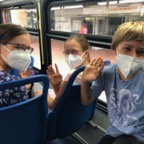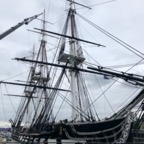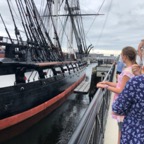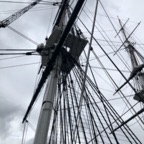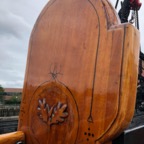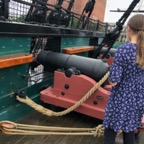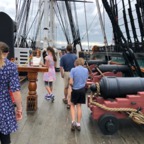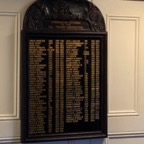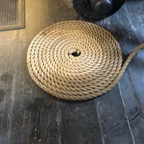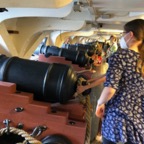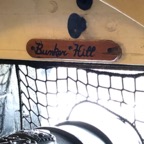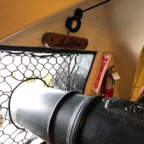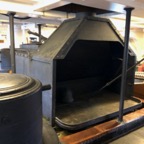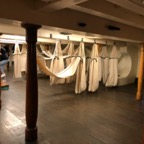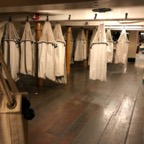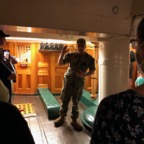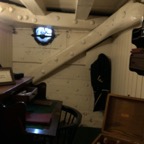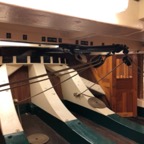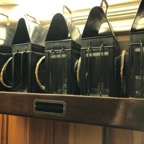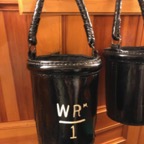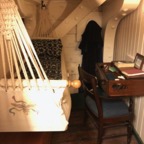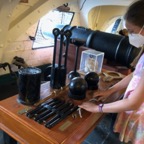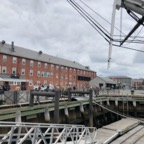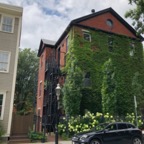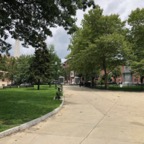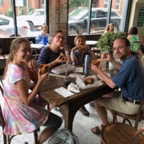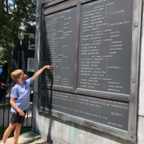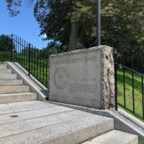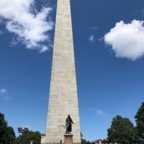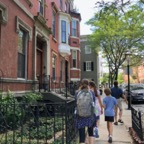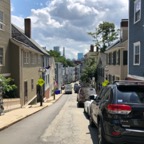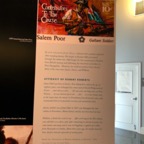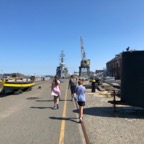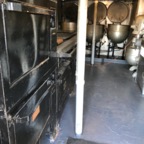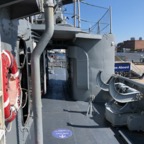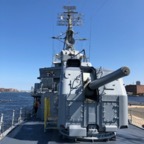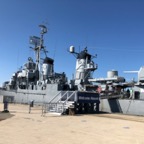Boston: Famous Ships and Bunker Hill
On July 28 we spent the day at Charlestown Navy Yard, which was just across the Charles River from Boston. They had several ships there as well as a maritime museum.
We visited the USS Constitution, (nicknamed “Old Ironsides”) first. Old Ironsides is a three-masted wooden-hulled frigate of the Navy, launched in 1797. So she is one of America’s first ships! Her most famous actions took place during the war of 1812, and engaged in a famous battle with the HMS Guerriere. Many of the cannon shots bounced off her wooden sides, which earned her her nickname.
We visited the whole ship, talked to the sailors about what taking care of Old Ironsides was like and what their lives were like. We also got a sailor to explain an exhibit to us about all the kinds of objects that could be loaded into a canon and shot – they had all kinds of different purposes!
We went out to lunch in Charlestown (the town next to the harbor) at a bakery called Tatte, which (like Flour) had delicious pastries and sandwiches. We also talked at length with a guy sitting in the main square who drove an ice cream truck for a living. He’d lived in Charlestown all his life and told us about what it was like when he was a kid (it was apparently a pretty rough neighborhood, with Irish gangs).
Then we climbed Bunker Hill and visited the monument and talked a lot about the battle of Bunker Hill in the American Revolution. There was a little museum about it that we visited after the monument which gave lots of detail and maps about the battle and artifacts. They know a LOT about this battle, including an exact timeline, and where particular individuals were located at different times.
One of the most painful parts of the museum was reading about how one of the patriots at Bunker Hill had three sons kidnapped and sold into slavery. It boggles the mind. I am very glad to see these stories come to light, because these stories were hidden before, and not mentioned in museums, by European-Americans who were either ashamed, indifferent, or ignorant of these stories. But this, too, is America.
It reminds me of the signs being posted in Paris, over the past ten years or so, about the deportations of Jews to Germany in World War II. This just wasn’t talked about before. It was quietly known, but not admitted openly. It is only now being officially recognized, finally. I remember walking along the Champs Elysees in 2014 and seeing a whole open-air exhibit about collaboration. I just learned, last year, that there was a WWII deportation camp at Les Milles, a little town near Aix. In all my years living there in the 1980’s and early 90’s nobody ever mentioned this camp, even when we studied WWII in school.
Another thought-provoking part of the museum for me was a binder of letters from people in Boston about the battle of Bunker Hill. Some of the letters were enthusiastic about the battle, and proud of the actions of the townsfolk against the soldiers, while others were horrified and angry that a group of rag-tag locals would fire on their own soldiers, who were upstanding young men of good character, some of the best young men that Britain had, who were there to keep peace and order.
To me, this highlighted something essential about the nature of the American Revolution, that I think can get lost in the way that it is often thought about. It is easy to think that the Revolution was about ‘Americans’ throwing off ‘British’ rule, as though the British were a foreign force. But the British were NOT a foreign force in Boston. Boston was a part of the British Empire and its inhabitants were British. The townsfolk and the soldiers, the Minute Men and the officers, the residents in the cities and towns of New England were all British – as British as the people in Britain. So, the Revolutionaries were firing on their own countrymen. The original disagreement was more about the British subjects of the colonies wanting the same representation the government as their fellow British subjects got in Britain. It was not an unreasonable request, to have the same rights as one’s countrymen.
These letters let us catch a glimpse into this amorphous, turbulent time when the divisions in the population were just starting to appear. Some letters were written by people who identified with the townsfolk of Charlestown, while other writers identified with the soldiers and officers. But all this was before the terms ‘Patriot’ and ‘Loyalist’ became part of people’s identities. Basically, the population was in the process of needing to have an opinion about this issue, of needing to take a side.
We know how things turned out, of course, we know that the Loyalists’ side ultimately lost, and many loyalists would leave the country, but this was not the case yet at the Battle of Bunker Hill. Nobody knew how this would turn out, and people were just starting the process of having to pick a side. The loyalist also had good arguments, about citizens needing to pay taxes to pay for their own defense, and to work things out non-violently. It’s only later that this position lost and was sidelined, and therefore appears so much smaller in retrospect than it really was.
History is lived forwards, and it’s easy to forget all the other paths that history MIGHT have taken. But these multiple paths are very much in the minds of people living at the time, living their lives forwards, and having to make decisions about which path to take. Sometimes their behavior can only really be understood if you understand the choices that were available to them at the time, and the events of their own recent past that might influence their decisions. They could not draw on the future for advice on which path to take.
In my head I keep a timeline of history, with the span of a human life which can be moved back and forth on this timeline, like a little ruler can be moved back and forth on a super-long ruler. The human-lifespan ruler has several divisions on it, for birth, childhood, adolescence, young adulthood, middle adulthood, late adulthood, and old age. Each of these periods is subject to different kinds of experience -- especially the formative years of childhood, adolescence, and young adulthood. This experience is direct, but it also comes from the stories told by older members of the society, like one’s parents, grandparents, or other older adults.
The decision-makers at any given time tend to be middle- to late adults, people aged 30 to 70 or so. So when you look at the decision-makers of any given period, like WWII, you line up the “middle” or “late” adult section of the little lifespan ruler with 1942, and you can see that the childhood and adolescence of these adults took place during WWI. Living through WWI as a child or adolescent, or especially as a young adult who might actually have gone to war personally, would have an enormous impact on these decision-makers, which would have profoundly colored their view of the events of the late 30’s and early 40’s and would have had a major impact on their decisions.
Anyway, I run this lifespan ruler back and forth on the big timeline quite a lot in my mind. It reveals fascinating overlaps of lifespans, too. For example, my Mom, who was born in 1931, knew veterans of the Civil War, who were very old at the time. But that’s who the elderly WERE in the 1930’s – they were people who had been adolescents and children during the Civil War. My mom would also have overlapped with people who had formerly been enslaved. Any African American person who was over 65 in Florida in 1931 would probably have been born in slavery. All of the elderly in the 1930’s had been the children and teens of the 1860’s. Meanwhile, the middle-aged African Americans of her childhood were probably the children or grandchildren of formerly enslaved people.
And my grandfather, who was born in 1885, definitely overlapped with former slaves. His formative years would have taken place in the 1890’s and 1900’s, when any African Americans who were middle aged or older would have probably been formerly enslaved people. Only the youngest African Americans around him – the children, teens, and youngest adults -- would have been born free.
Sliding the lifespan ruler further back in time, the people who were elderly during the Civil War would have been children and adolescents during the American Revolution. And so you can run it further and further back, looking at when the decision-makers’ formative years were, and who the elderly were in any given period of time.
ANYWAY, in the afternoon we returned to the harbor and visited the USS Cassin Young, a destroyer commissioned in 1942 (and, to continue the perspective, she would have been built by people who remembered, and perhaps fought in, WWI). Her most famous battles were in Warld War II in the Pacific. We explored the whole ship, top to bottom.
We visited the Navy museum after the ship, and learned a great deal about the USS Constitution (commissioned in 1797, and built by people who had lived through the American Revolution). The museum was geared toward kids, with dress-up activities and panels to lift and videos to watch. There were exhibits on who tended to become a sailor, what sailors’ lives were like, and what happened to them after they returned to land. It was well done! Some of the rooms were a little tight, with kids we knew could not be vaccinated yet, so we kept moving through areas with more people.
We took the bus home, and had another yummy homemade dinner with fish and lots of vegetables on a bed of greens.
